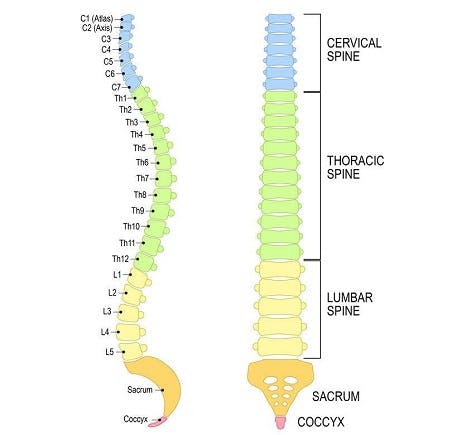No products in the cart.
No products in the cart.
No products in the cart.
No products in the cart.
Home » Neurological Recovery Blog » Spinal Cord Injury » Types of Spinal Cord Injury: Complete vs Incomplete, Levels, & ASIA Scale
Last updated on September 9, 2020

There are many ways to classify the different types of spinal cord injuries. Some refer to the severity of the injury, while others refer to the level of injury.
To help you differentiate between multiple types of spinal cord injuries, this article will explain the various ways to classify an SCI and what they mean.
Types of spinal cord injury this guide covers:

There are two main types of spinal cord injuries: complete and incomplete. Completeness of injury refers to the severity of the spinal cord lesion. This is the most general way to classify spinal cord injuries. Depending on the completeness of injury, functional outcomes and recovery outlook can significantly vary.
In the following sections, we’ll discuss the major distinctions between these two types of spinal cord injuries.
A complete spinal cord injury is the result of a fully transected spinal cord. Generally, damage to the spinal cord cannot reverse itself. Therefore, with a complete injury, signals from the brain are not able to travel past the site of injury, because no spared neural pathways exist.
Likewise, sensory signals from areas innervated below the level of injury will be unable to reach the brain. As a result, individuals with complete spinal cord injuries experience both paralysis and loss of sensation below their level of injury.
The outcomes of incomplete types of spinal cord injuries can vary extensively. Incomplete spinal cord injury refers to a lesion that does not completely transect the spinal cord. As a result, some neural pathways will not be affected by SCI, which means individuals may be able to control or feel some areas innervated below their level of injury.
Depending on the severity of their spinal cord injury, the amount of preserved sensorimotor functions will vary. One major difference between complete and incomplete spinal cord injuries is that incomplete SCI patients are often capable of functional recovery because they have spared neural pathways at their level of injury.
Neuroplasticity is the central nervous system’s ability to rewire itself. Functions affected by incomplete injury can be reassigned to healthier regions of the spinal cord and strengthened through massed practice. However, neuroplasticity is limited. Generally, the less severe one’s SCI is, the more spared neural pathways they have, and the greater the recovery potential.
Now that you understand the differences between these two types of spinal cord injuries, let’s go over the various levels of injury.

Whether it’s a complete or incomplete injury, every spinal cord injury can also be classified based on the level of injury. Level of injury refers to the lowest area of the spinal cord where motor and sensory functions are normal.
Determining the level of injury is essential to understand which functions can potentially be affected.
The spinal cord is protected by the spine and separated into 5 regions (from top to bottom):
For both a complete and an incomplete spinal cord injury, determining one’s level of injury will help individuals understand what functions will or will not be affected.
Learn more about spinal cord injury levels »

Another common way to classify different types of spinal cord injuries is to refer to the ASIA impairment scale, which is a standardized neurological exam to determine the sensory and motor levels that were affected by SCI.
The ASIA impairment scale consists of 5 categories:
The ASIA classifications listed above have additional more detailed criteria that your physician(s) and therapist(s) may use to help understand your injury and predict your functional outcomes.
Instead of simply classifying a spinal cord injury as complete or incomplete, the ASIA impairment scale helps the rehab team understand the amount of sensorimotor functions a patient has.
Understanding the different types of spinal cord injuries is essential because it helps care providers recognize what functions may or may not be affected and create a personalized rehabilitation plan.
While the type of SCI plays a critical role in the rehabilitation process, there are also many controllable factors that can impact functional recovery.
For example, patients can control the intensity of their exercises, how much they move throughout the day, and what they eat. These factors can affect energy levels, circulation, and stimulate neuroplasticity in the spinal cord.
Hopefully, this article helped you better understand the various ways to classify a spinal cord injury. Good luck!

Get instant access to our free exercise ebook for SCI survivors. If you liked this post, you’ll LOVE our emails and ebook.
Each exercise features pictures of a licensed therapist to help guide you. You’ll also receive our popular recovery emails with SCI survivor stories and other useful tips — you can opt out anytime.
We will never sell your email address, and we never spam.


Flint Rehab is the leading global provider of gamified neurorehab tools. Check out our bestselling tool by clicking the button below:
Depending on the severity of your spinal cord injury, there may be hope for improved mobility. Consistent at-home therapy is key to making this happen.
That’s why Flint Rehab created FitMi, a motion-sensing, gamified home recovery tool designed for neurological injury like SCI.
Here’s what others have said about it:
“I purchased this wonderful equipment for the use of spasticity for my right hand. Initially I wasn’t sure if it would work because of the various treatments I tried and also many physiotherapists who tried their level best, but didn’t achieve any positive results.
However after trying FitMi, I could feel that slowly and steadily I am improving. It’s really a great device that minutely takes care of each and every muscle of your affected body part. The biggest plus point is, you can use this device anywhere, anytime with precise exercises that you need and also saves your money and time spent on your physiotherapist.“
— Chandrakiran
FitMi works by encouraging you to practice rehab exercises with high repetition. On average, survivors complete hundreds of repetitions per half hour session.
“Massed practice” like this helps stimulate and rewire the nervous system. While you can achieve massed practice with a written sheet of exercises, it can be tough to stick with it consistently — and consistency is key to recovery.
FitMi helps transform rehab exercises into an engaging, interactive experience. The yellow and blue “pucks” track your movement and provide feedback. All of this comes together for a motivating home therapy program.
A survivor named Tom put it perfectly:
“I believe this device will help me concentrate on making the repetitive actions needed to obtain further movement range in my wrist and hand and arm and therefore rating it with five stars. My occupational therapist recommended to give this a try. I have been using FitMi for just a few weeks. I feel more at ease in flexing.”
If you’d like to learn more about FitMi, click the button below:

Do you have this 15 pages PDF of SCI rehab exercises?
Get a free copy of our ebook Rehab Exercises for Spinal Cord Injury Recovery. Click here to get instant access.
Grab a free rehab exercise ebook!
Sign up to receive a free PDF ebook with recovery exercises for stroke, traumatic brain injury, or spinal cord injury below: